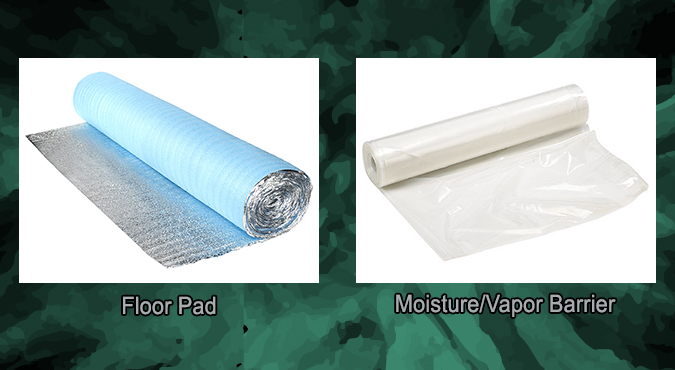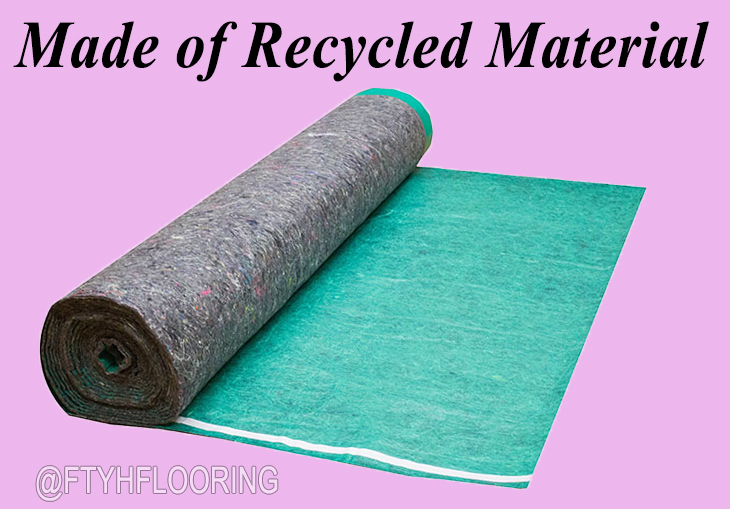4 Things You Need To Know About Floor Pad

We talk a lot on this blog about how important it is to do your research. Trust me on this one: the headaches of research now are worth their weight in migraine prevention gold later. Lost in the metaphors yet? Me too. Let’s break it down further: Research will save you time and money, because it lets you make an informed flooring decision and prevent problems down the line.
Not only is this true for your flooring material, it’s also true for your underlayment. Choosing the right pad is critical for a long and happy life with your floor. Here are five important things to keep in mind during the research and selection process.
‘PAD’ AND ‘MOISTURE BARRIER’ DON’T ALWAYS MEAN THE SAME THING
Most of today’s underlayments do have built-in vapor barriers that resist moisture diffusion through walls and subfloors. It’s a well-known fact that prolonged moisture exposure can be detrimental to flooring materials like hardwood and laminate; the best thing you can do is prevent those problems before they start. A moisture barrier is a very thin sheet of plastic that goes on top of the subfloor. It’s usually 6 mil thick - 6 micrometers, or 6 tenths of a millimeter – I know it sounds small, but it’s more than enough to get the job done.

Be sure to check that your underlayment has a moisture barrier; even if you’re using a laminate with attached pad you may still need to use a moisture barrier. Check the manufacturer’s specifications, ask your installer, or call your flooring retailer if you’re unsure. Better safe than sorry!
What’s The Difference Between A Moisture Barrier And A Vapor Barrier?
These two terms are used interchangeably when talking about floor pad. If your underlayment advertises a vapor barrier as opposed to a moisture barrier, there’s no need for confusion. It will also work to block moisture and you won’t need to add an additional layer of pad.
THERE IS A GREENER OPTION
It is possible to get premium protection while still looking out for the environment. Our best-selling SuperFelt underlayment is made of recycled felt fibers that offer superior warmth and sound-proofing. Since this is a thicker pad, it may not be suitable for all floors, so be sure to check your manufacturer’s specifications before purchase and installation.

IT’S IMPORTANT TO UNDERSTAND YOUR SUBFLOOR
A great life with your new floor doesn’t start with the material you choose – it starts with your subfloor. Odds are you have one of three types of subfloor:
• Cement • Wood • Pre-Existing Floor Covering
Creating a level surface is critical regardless of what kind of subfloor you have. Seams, grout lines, and imperfections will all need to be repaired prior to installing your new floor. This will prevent myriad issues down the line. For a more in-depth look at subfloors, check out this post on what’s a subfloor is..
Your subfloor type will help you choose your perfect underlayment. If you have a concrete subfloor, particularly in an area like a basement, moisture can be an issue, so you’ll definitely want a vapor barrier. Unchecked moisture from concrete subfloors can lead to mold, compromised adhesives on glued down flooring materials, and warped flooring.
Moisture prevention is also important for wood subfloors. Whether you have a plywood subfloor or a plank subfloor, a moisture barrier or underlayment paper will help prevent moisture problems before they start. Again, don’t forget to check your manufacturer’s specifications and talk to your installer!
Underlayment can cover up very minor subfloor imperfections, but it should not be seen as a substitute for taking the proper leveling measures. Remember, a level subfloor is critical!
DON’T FORGET RUG PAD!
Throw rugs are one of our favorite ways to add charm and personality to a room. With reasonable price points and an endless supply of styles it’s easy to find a throw rug that meets your needs and matches your decor. They’re also great for covering up flooring imperfections, stains, or scratches. The only issue? Unsecured throw rugs can be slippery on smooth surfaces like laminate and hardwood.
Is this a major issue? Not really, no…until someone trips over a bunched throw rug. Non-slip grippers and pads are available at most home improvement stores; some are the more traditional checkerboard-style rubber, but some newer models are made of felt or felt-rubber combinations.
Follow Team Floors To Your Home on Facebook

 Brown Tone
Brown Tone
 Red Tone
Red Tone
 Golden Tone
Golden Tone
 Gray Tone
Gray Tone
 Light Tone
Light Tone
 Medium Tone
Medium Tone
 Dark Tone
Dark Tone
 Brown Tone
Brown Tone
 Red Tone
Red Tone
 Golden Tone
Golden Tone
 Gray Tone
Gray Tone
 Light Tone
Light Tone
 Medium Tone
Medium Tone
 Dark Tone
Dark Tone
 Multi Color
Multi Color
